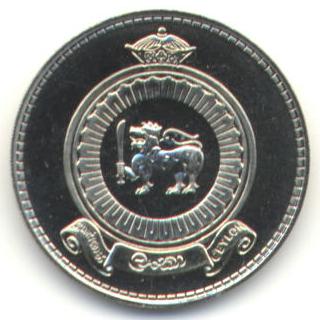

| ||||
| KM127 | One | Cent | aluminum | coin |
| KM128 | Two | Cent | aluminum | coin |
| KM129 | Five | Cent | nickel-brass | coin |
| KM130 | Ten | Cent | nickel-brass | coin |
| KM131 | TwentyFive | Cent | copper-nickel | coin |
| KM132 | Fifty | Cent | copper-nickel | coin |
| KM133 | One | Rupee | copper-nickel | coin |
In 1956, the British Monarch portrait was replaced with the Armorial Ensigns of Ceylon and the main lettering changed from English to Sinhala. New currency notes were issued 1956 July 30th, and new coins were issued in 1963.
According to the 1963 Royal Mint Annual Report (94th), the design was modelled by Mr Cecil Thomas, O.B.E. from drawings supplied from Ceylon.
The Centenary of decimal coinage in Ceylon 1971 was also the last year in which English name "Ceylon" was used on coins. The Central Bank approved of the Royal Mint making 1971 Ceylon coins as one of its limited editions of 20,000 proof sets to be marketed along with the Mint's `Coins of the World' series. (Sallay 1986).
| The set of 7 coins embedded in blue hard board with CEYLON 1971 printed in gold lettering on top of reverse side is encased in clear plastic and enclosed in a yellow soft-board envelope printed in gold with the Central Bank Emblem below which the text on right. Double sided triple-fold information card of same material and color, with history and descriptions of each coin enclosed |
OF CEYLON CEYLON COINAGE |
According to the Royal Mint Annual Reports these proof sets were not minted in 1971/2 or 1973/4. 6,850 minted in 1974/5 and 7,157 in 1975/6 and none in 1976/7 the last year the Report was published. Totals 14,007 need to check 1972/3 report to clarify if the full 20K approved were minted
Marketed mostly abroad few sets were sold by the Central Bank of Sri Lanka from which I obtained a set in the early 1990's. It sells frequently on internet auctions for under $15.
Note that the Armorial Ensign of Ceylon on these coins and on Currency of this Era has the name of the nation in Sinhala as "Lanka" excluding the "Sri" as was the name of the island in the ancient Ramayana. This was pointed out by Sallay in his 1985 book (p.34) This series of coins adopt this name and have excluded the "Sri"
This is particularly intriguing since stamps issued since independence in 1948, and Currency since 1958 have the name in Sinhala as "Sri Lanka" which was made the official name with the adoption of a new constitution for the Democratic Republic. The name of the country in native sinhala text first appears in the 1957 Buddha Jayanthi commemorative coins which also has it as Sri Lanka.
IMHO the "Sri" should be dropped from the name of the nation since the adjective "Sri" including on the vehicle number plates was one of the very first ethnic issues between the Sinhala majority and the Thamil minority. Although a minor issue it is a clear reminder of the short-sighted view of some Sinhala politicians wanting to abuse their power for political advantage. They sacrificed the future stability of the nation for instant political advantages, which over time has led to the civil war in Lanka since 1983.
I am just a rational scientist. I see all persons as humans and ignore race, religion or nationality as worthwhile criteria. Among humans there some who are intelligent and some who a ignorant, some who live in harmony with the environment and some who exploit it, some who live at peace and some who profit by war. I have sympathy over the ignorant and hope they get educated, and wish that those who profit by war and exploit nature will some way reform and leave life on the Earth at Peace and in harmony with nature.